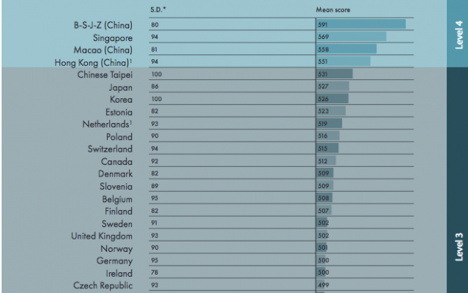December 13th, 2019

The reports are coming in, and they each speak of declines in the number of international students at U.S. institutions of higher education (HEIs). Panic has set in and decisions based on panic never turn out to be sound or prudent. They are short sighted and cause more damage than good. Panic prompts HEIs to retrench, which leads to laying off staff in international admissions and cutting back on student recruitment. The drop in international student numbers shows itself quickly with a decline in dollars generated from tuition and fees which prompt universities to slash their budgets, cut back on staffing that translate to reduced course offerings and less seats available for prospective domestic students. People forget that the tuition from international students help subsidize a large portion of the infrastructure of institutions, supporting more courses and faculty and more seats available to domestic students. International students also help by participating in the general economy, they are, after all, consumers just like you and me and besides paying their college tuition, they are also spending dollars in the local community.
No matter who or what political party is in power, we forget that the U.S. economy hinges on the global market and our global competitiveness is in trouble, which includes our competitiveness in the international student market. Combining the number of international students in the US government’s net migration target is a flawed policy. We have and continue to have a political environment laden with extreme political opinions where one group is adamantly pro and another passionately against internationalization. Neither point of view is accurate since extremes in any which way tend to be flawed and too simplistic on how the domestic and global market are intertwined and function together as a unit and not separately. The more we remain engaged globally the more we can encourage the coming together of people, ideas and innovations, that will help us better address the challenges that face us.
When the political climate insinuates that internationalization is bad, it trickles down to all sectors of the economy and community, and those of us in international education feel its immediate effects on our campuses and in periphery services supporting our HEIs. Suddenly, there is a dis-ease within the international student community about coming to the US to study. They fear for their safety, they anticipate difficulties in obtaining a student visa and express concern about how they will be treated on arrival at a U.S. airport by customs and immigration officers and by their peers on the university campuses. We have, unfortunately, not been sending a warm welcoming message to the world in this past year and it is resonating loudly and clearly around the globe.
Say what we want, but we live in a competitive world, and when it comes to international education, the U.S. HEIs are competitive to the extent that they remain in the field. Rather than retreating, U.S. HEIs must stay in the game and compete successfully with their counterparts in UK, Canada, Australia, and emerging markets such as China and India. In fact, this is exactly the time for HEIs to collectively work on maintaining a robust marketing and promotion campaign to counter the negative perceptions about international education and students by dispelling myths that deter students from wanting to study in the U.S.
What must US HEI’s do?
1. Intellectual Contribution: Reinforce and Raise Awareness
In an article in The Times Higher Education, Dame Nemat Minouche Shafik, Director of the London School of Economics and Political Science states: “…we need to reinforce, raise awareness of and spread the well-established principles that govern what constitutes a valid intellectual contribution. Practices such as peer review, competitive process for funding research, requirements to publish data, and transparency about conflicts of interest are fundamental to academic life. Most people are unaware of these practices, which are the bedrocks of academic quality and progress – we need to spread the practices to other domains such as think tanks and the media.” These are the hallmarks of U.S. higher education and US HEIs need to carefully craft the language that expresses and conveys this to the public without sounding elitist or academic.
2. Messaging
Which brings us to messaging. Where we seem to have faltered is in our messaging and doing a so-so job at communicating without sounding self-serving. We need to turn things around and emphasize the benefits brought to the community and country by international education and students. We need to use the Internet and social media platforms effectively and share personal stories and progresses in research in a language that is approachable and inclusive, one that will draw in the very camp that is opposed to internationalization. In the same report in the Times Higher Education, Dame Shafik suggests one way to accomplish effective messaging is by “working with thoughtful and effective storytellers to reach a wider public – consider, for example, Sir David Attenborough’s work to raise awareness of the environment or Michael Lewis on the risks inherent in financial markets.” Here are a few suggestions to incorporate in our individual and collective messaging on the unique benefits of international students and scholars:
- Promotes U.S. foreign policy and international leadership
- Helps the growth of U.S. knowledge economy
- Spending by the international students and their dependents contributes significantly to the U.S. economy (approximately $13.5 billion)
- Education exchange is benefits U.S. education as much as it does the international students
- Education exchanges enhances and ensures U.S. security
3. Tools to Train an Informed Citizenry
While we craft the messaging to the world outside our campuses, our work as educators means that we must also commit to teaching and training our domestic students to become more discerning citizens. We need to teach them the tools they need that will instill in them an appreciation to be critical thinkers, learn how to distinguish propaganda and disinformation from facts so they are better prepared to engage and debate as informed citizens. Our domestic students will serve as our campus ambassadors and who better than they to welcome the international students.
4. Promote Healthy Debate
From teaching and training students to be critical thinkers, we segue to what is deemed as challenging by most and that is creating a space that respects different opinions and allowing both sides to debate and share their points of view, no matter how uncomfortable it makes us feel. Absence of this neutral zone for public debate hinders any progress we would like to see in raising awareness on the importance and benefits of institutions of higher education. By allowing and fostering healthy debate on our campuses, we can help broaden the minds of our domestic students who may have a narrow opinion on what it is to be an international student.
5. Promote Diversity and Foster Inclusion
Whether it is our intellectual contributions, messaging, training and informed citizenry, and promoting healthy debate, one thing we cannot and should not forget is that the USA is not a homogenized nation but one that is uniquely diverse whose citizens have ancestry representative of every country on the planet. Simply put, what makes the USA unique is the sheer magnitude of its diversity of people. In fact, this diversity must and should be front and center in our conversation with potential international students. It is this diversity that sets the US apart and we should embrace and promote it.
6. Support Study Abroad
Promoting internationalization on our campuses, is a two-way street. At the risk of sounding repetitive, since this message has been expressed before by others, our HEIs need to demonstrate their commitment by being global leaders in higher education by having in place a robust study abroad program and encourage and support study abroad opportunities for their domestic students, and preferably to countries where learning a foreign language is a prerequisite. This experience will foster a camaraderie and mutual understanding between a returning domestic student from studying abroad and a fellow international student at his/her home campus.
7. Don’t Abandon the Marketing Plan
At the sight of trouble, or a downturn in economy, businesses tend to quickly react and slash their marketing budgeting. HEIs do the same, they cut back on recruitment, outreach, and promotion of their programs overseas. Rather than putting marketing on an indefinite hold, a plan needs to be thoughtfully put into place as to how to keep the messaging alive and robust. The first sign of retreat and defeat is to slam on the marketing brakes when the economy is slowing down. We need to keep the messaging consistent, clear and loud.
If we are not careful and let panic set in, the years of work that have made the US an attractive destination for education for students from around the world will be lost and regaining that competitive edge will take a very long time to recover.
HEIs needs to demonstrate the benefits of international education and international students and their value to the community and US economy. HEIs must not simply accept the current dictates set by government as a given. Rather than retrench and retreat, we need to push on and keep at it!
Is your institution experiencing a decline in the number of international student applications? Please share with us what steps your institution has taken or is taking to address this issue.
Sources:
https://www.timeshighereducation.com/opinion/experts-must-fight-back
http://www.nafsa.org/uploadedFiles/NAFSA_Home/Resource_Library_Assets/Public_Policy/restoring_u.s.pdf
https://www.insidehighered.com/news/2018/01/22/nsf-report-documents-declines-international-enrollments-after-years-growth

Jasmin Saidi-Kuehnert is the President and CEO of the Academic Credentials Evaluation Institute (ACEI).





















